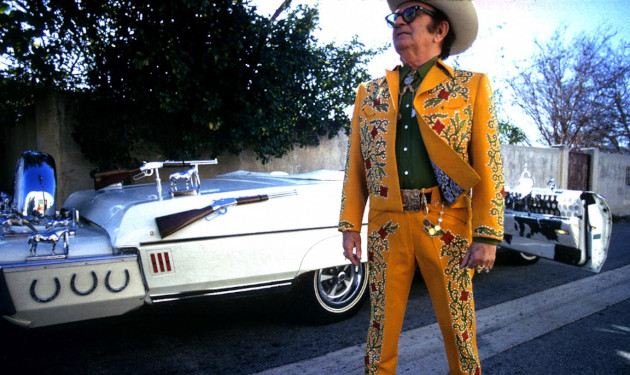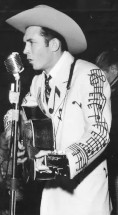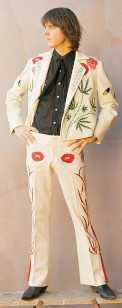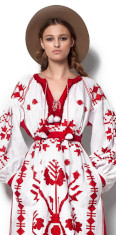Nudie Cohn: The Ukrainian Refugee Who Created the Image of Country Music

It was 1913, and ethnic Jews living in the Ukraine region of the Russian Empire were regularly subjected to brutal, mob-like massacres, known as pogroms. Just two years after a young boy named Nuta Kotlyarenko (Нута Котляренко) was born in Kyiv on December 15th, 1902, one such notorious pogram ensued on the streets of Kyiv after the collapse of a City Hall meeting, which resulted in the massacre of an estimated 100 Jewish people.
As numerous other such massacres transpired throughout the western portions of the Russian Empire, Nuta Kotlyarenko’s parents—fearing for his life—put the boy and his brother Julius on a ship bound for America. That boy would go to become arguably the most important person in country music history that never played and instrument professionally.
When you go to the Country Music Hall of Fame in Nashville, there is one man’s influence you will see more than anyone else’s. No, it’s not the Father of Country Music Jimmie Rodgers, or the first King of Country Hank Williams. It’s the timeless work of that Ukrainian refugee from Kyiv who would later go by the name Nudie Cohn.
And it doesn’t just stop there. Go to Graceland in Memphis, the Rock and Roll Hall of Fame in Cleveland, or many museums covering the silver screen cowboys of the 50’s, and there you will find ample evidence of the importance of this Ukrainian throughout American culture.

Now to be historically accurate, Nudie Cohn did not invent the Western style suit that his name is now synonymous with, and was not the first to employ it in country music. This was the doing of one of the first country bands ever, Maddox Brothers and Rose, who became known as “The Most Colorful Hillbilly Band” for their striking and garish stage costumes. Nathan Turk also deserves credit for being one of the original Western tailors for country music—a Polish immigrant himself, as does Manuel Cuevas from Mexico who was an understudy of Nudie and initially worked for him. But it was Nudie Cohn who took it from a fad to an art form that has withstood the test of time, and become the very image we associate with classic country today.
First arriving in the United State at the age of 11 on Ellis Island in New York, this is where Nuta Kotlyarenko’s name was Americanized. Nudie Cohn worked as a shoeshine boy to get by, and later as a boxer, allegedly with ties to legendary mobster Pretty Boy Floyd. After doing time in Leavenworth for trafficking drugs (likely for the mob), Cohn met his American-born wife Helen Barbara Kruger—later known as Bobbie Nudie—in a Mankato, Minnesota boardinghouse.
It was 1934, and in the midst of the Great Depression. The young couple had a harebrained idea to open an undergarment shop for showgirls and prostitutes in New York City called “Nudie’s for the Ladies,” and the Nudie’s were officially in the clothing business. But it became apparent early on that Nudie’s signature style of chain stitch embroidery would be better suited (no pun intended) for Western Wear that was becoming all the rage on the American West Coast. So he relocated to Los Angeles, and soon became the tailor of country music.
Country singer Tex Williams is where Nudie Cohn got his start in country music. The suits he wanted to make were so expensive, you couldn’t just start making them on spec. So while supporting himself designing mass manufactured clothing in his garage with his wife, Cohn swung a deal with Tex to take the proceeds Tex made from selling a horse to purchase a sewing machine so he could make the singer’s stage clothes.
Tex became like a walking billboard for Nudie, and it worked. Soon Nudie Cohn opened the famous “Nudie’s of Hollywood” on the corner of Victory and Vineland, and later “Nudie’s Rodeo Tailors” on Lankershim Boulevard, accenting Nudie’s gift for the chain stitch embroidery with Rhinestones.

It was the music of artists such as Hank Williams, Elvis Presley, Porter Wagoner, and Gram Parsons that made them famous. But the image we all conjure of these artists whenever their music comes to mind sprang from the imagination of Nudie Cohn. Hank’s famous white suit with the black musical notes waterfalling down the sleeves and legs was a master work of Nudie Cohn. Porter Wagoner eventually owned 52 Nudie Suits, with each one costing roughly $11,000 to $18,000 (not adjusted for inflation), with one of the most popular Nudie suits of all time being Porter’s peach Wagoner suit with a covered wagon on the back, and wagon wheels down the legs.
The Gram Parsons Nudie Suit worn as part of the Flying Burrito Brothers’ The Gilded Palace of Sin album in 1969 with the pills and marijuana leaves emblazoning the coat made it a countercultural and cross-cultural revolution. Soon, the artists who didn’t wear Nudie Suits in country music were easier to count than the ones that did, while wearing the suits crossed well over into the rock and popular music world.
Elvis got the idea of wearing Nudie Suits after once opening for the Maddox Brothers and Rose, and endearing himself with the clothing style. Elton John began wearing them on stage in the 70’s. ZZ Top appeared in Nudie Suits on the cover of their 1975 album Fandango!. Even more modern artists outside of country music such as Post Malone and Kesha have sported the style.
The Nudie Suit became a statement beyond fashion. It crafted the initial persona for country music Outlaw David Allan Coe, who after Mel Tillis gifted the up-and-coming performer numerous Nudie Suits, he started wearing them all the time around town and calling himself The Mysterious Rhinestone Cowboy. The clothing style played a seminal role in the 1979 film Electric Horseman starring Robert Redford.
Nudie Cohn also designed cars, customizing 18 vehicles in his heyday, mostly Pontiac Bonneville convertibles, including the one sitting in the Country Music Hall of Fame with pistol door handles and rifle sidebars designed for Webb Pierce, and another that appears in the 1988 video for “The Streets of Bakersfield” featuring Dwight Yoakam and Buck Owens that was originally meant for Elvis Presley, and now sits in Buck’s Crystal Palace in Bakersfield.
But even though the Nudie Suit is now synonymous with country music and Western American culture, there is a distinctly Ukrainian influence in the style. The Rhinestones may come from Germany, but the chain stitch embroidery style is distinctly Asian and Eastern in origin. Imported into Russia and the Ukrainian region via the Silk Road, looking at traditional formal Ukrainian dress, it is very similar to classic American Western wear, just not as gaudy.

So yes, there is a significant influence of Ukrainian culture in American country music, believe it or not. And all you have to do is flip through the pages of a country music history book, or stroll through the halls of the Country Music Hall of Fame to see it splayed out in all of its brilliance, including dedicated displays to Nudie’s contributions.
But what you won’t see is Nudie Cohn recognized as a member of the Country Music Hall of Fame itself, even though when he passed away on May 9th, 1984 at the age of 81, many country music stars attended the funeral, and mourned his passing as if he was one of their own—not a servant or a side participant in the music, but an equal player.
Many country music artists have contributed to the sound of what we consider “country music” in small and significant ways, all intertwining into a melting pot of influences. But few if anyone contributed to the image of country music to such a great degree than that hungry and desperate Jewish refugee from Kyiv, Ukraine fleeing oppression who came to be known as Nudie Cohn.


February 27, 2022 @ 12:27 pm
What a cool story, so glad he left his mark. I learn something new every day.
February 27, 2022 @ 12:36 pm
Fascinating cool stuff right there.
February 27, 2022 @ 1:04 pm
Great History Lesson!
That’s what I love about this site!
February 27, 2022 @ 1:23 pm
Hell yeah!!!
February 27, 2022 @ 3:25 pm
Beautiful.
Thanks much for this.
Nudie, Ray Benson, Kinkster.
Three of my favorite Jews.
Ray is the tallest.
L’chaim.
February 27, 2022 @ 4:12 pm
#Induct Nudie Cohn into the CMHOF, and R&R HOF
Like his car – but i would take the shotgun off the trunk lid, & mount it to the hood.
February 27, 2022 @ 5:09 pm
Interesting, I really never looked into Nudie Cohen definitely belongs in the hall of Fame.
February 27, 2022 @ 5:13 pm
That picture of him resembles Roy Orbison
February 27, 2022 @ 6:53 pm
Used to go into Nudie’s on Lankershim Blvd. in North Hollywood, California to buy cowboy boots.
February 27, 2022 @ 8:23 pm
I read this: “I remember Marty Stuart telling a story about the first time he went to Nudies to get a suit and didn’t have near the fee. Manuel took him aside and hooked him up with a nice fitted shirt, gratis, and told him to come and see him in a few years. (paraphrasing of course but once he made some money, Marty returned and became a loyal customer.”
Thanks Trigger for an invaluable history lesson.
February 27, 2022 @ 11:37 pm
Hey. Trigger , William Lee Golden just shared your post on Twitter. Thought that was pretty cool.
February 28, 2022 @ 5:20 am
A great story! Today’s singers need to learn to dress up instead of looking like slobs. To watch the old-timers perform is always a treat to see how well-groomed they were in the day.
February 28, 2022 @ 5:34 am
I had no idea. Brilliant article.
February 28, 2022 @ 6:50 am
Love it!
February 28, 2022 @ 7:39 am
Manuel was Nudie’s greatest understudy. To this day, he’s highly in demand and his clothes are sought after by many. Johnny Cash, Dwight, and Marty are/were lifetime customers.My favorite Manuel story was when Cash went to Nudie to buy some suits, Nudie had Manuel assist him. Cash decided to give him all the creative control in designing them. Cash got the phone call one day that he had 5 suits ready to pick up. Cash was astonished to find they were ALL black suits. He asked Manuel what he was thinking. Manuel said something to the effect of “Mr Cash, there is no other color for you, you are The Man in Black.” And so it was decided! Much later, Cash gave a black Manuel jacket to a young and upcoming Country singer who couldnt afford fancy clothes at the time, that singer was none other than Ronnie Dunn. But without Nudie, Manuel would likely never have gotten the opportunity in the industry. A couple years back they built a Nudie themed restaurant on Lower Broadway as a tribute to the man.
February 28, 2022 @ 8:26 am
i’m a big fan. i have a nudie’s tshirt and i’ve been to manuel’s in nashville and chatted with him, even tried on some of his 50 states collection. one of these days, i’d love to have a suit, but there are so many options for what to put on them i don’t think i could ever settle on it.
February 28, 2022 @ 9:00 am
Thank you Trigger for covering (pun intended) the relevance of Nudie. One small detail I’d like to point out. “That boy would go to become arguably the most important person in country music history that never picked up an instrument.” Nudie did play the mandolin and his Mosrite mandolin is well known amongst collectors and aficionados of the mandolin world. He did not play professionally, but it was an important part of his life and he entertained many clients at parties at with his Mandolin.
February 28, 2022 @ 9:26 am
Great article!
February 28, 2022 @ 12:28 pm
Jerry Fuller wrote “Travelin Man” Is my brother. and I’m his sister.Lola Claudine Fuller West.
February 28, 2022 @ 2:55 pm
I was with my family looking through the window of Manuel’s one Saturday when it was still on Broadway. It was closed, so just window shopping. But before we left, someone came outside and invited us in. We tried on everything we liked and took pictures. Such friendly people. A little out of my price range, but it was sure fun. Sadly Manuel was not there. I would have loved to meet him.
February 28, 2022 @ 4:42 pm
A fascinating read. Thank you for writing it.
March 1, 2022 @ 10:05 am
If Nudie were really “mobbed up” at one time, it would not have been with Pretty Boy Floyd, who wasn’t even in a gang; he was just a lone outlaw. Give a listen to Woody’s retrospective: https://www.youtube.com/watch?v=JdeTr3lWPnY
March 1, 2022 @ 5:59 pm
Nudie Suits made Country Music, Cool ! Made TV Cowboys,glitter. Made Roy Rogers,Hank Snow,Porter Wagoner and Marty Stuart, sparkle.
Nudie needs to be in the Country Music Hall of Fame.
March 2, 2022 @ 2:23 pm
I own a Nudie created saddle. It was made for Sylvester Stallone for sale he movie ‘Rhinestone’ plus I have a beautiful Nudie suit
March 2, 2022 @ 5:52 pm
Shalom! Country music is full of good goyim 🇮🇱🇮🇱🇮🇱
March 6, 2022 @ 5:44 am
you got that right
March 8, 2022 @ 5:16 am
*Hand rubbing intensifies*
March 6, 2022 @ 8:46 am
My family just recently learned through Ancestry DNA tests that Manuel is actually my grandfather. He’s my mother’s father. My parents are actually at the airport as I type this headed to Nashville to go meet him. It’s crazy that this article showed up in my feed today. Mind blown.
March 6, 2022 @ 7:41 pm
Tyler Mahan Coe covered this IMPRESSIVELY in season 2 of cocaine and rhinestones.
This article feels like it’s strictly because of the Ukrainian aspect and it feels sleazy.
Would you be celebrating Nudie right NOW were it not for trendy click seeking Ukraine sort of stuff?
No.
Tyler covered it and he didn’t do it to focus on Jewish Or Ukrainian but HUMAN roots.
Talked about his creations and didn’t deify him do his ethnic roots as if such made him more special.
He’d be just as special if he was Swiss, Irish or Latino and this just feels like using the wrong reasons and motivations to talk of the man and it’s sleazy.
This site isn’t supposed to be Blake Shelton type of moves but to be ABOVE that.
You’re better than this. The Ukrainian aspect dishonors Nudie a little because right now it’s about sympathy and Nudie was very strong.
I’m distantly related and this just feels like doing an article on a black artist just cause it’s February know what I mean?
March 6, 2022 @ 8:06 pm
“Would you be celebrating Nudie right NOW were it not for trendy click seeking Ukraine sort of stuff? No.”
The point of this article was to illustrate how a Ukrainian refugee from Kyiv ended up having a significant influence on the image we all associate with American country music, hopefully to help create camaraderie with the Ukrainian people who are currently under siege. Of course the timing of NOW was all to tie it into the Ukrainian conflict. This is completely naked and out in the open, and is self-evident to anyone reading it. To act like you’re somehow exposing this article by mentioning something that’s so blatantly obvious shows how bad faith your criticism is.
Mr. Starchild, The Scut Farkus of Country Music, doesn’t have a monopoly on talking about the history of country music. It belongs to ALL of us. And it’s unfortunate that his arrogant, down-looking, self-aggrandizing self-righteous assholedry has become communicable among his obsequious toadies and sycophants to the point where someone would take offense to an article such as this. You’re not pissed off at this article. You’re pissed off this article was successful. And so you must undercut it.
I appreciate that you’re distantly related. I have spoken directly and at length with the executors and DIRECT descendants of the Nudie Cohn estate about this very article, and they were very grateful for its posting.
I appreciate your concern, and I always solicit for criticism and feedback. Your criticism was out of line.
March 9, 2022 @ 5:11 am
Photos of Nudie & Gram Parsons in this article created By Raeanne Rubenstein (uncredited)
March 9, 2022 @ 11:33 am
Members of the Grateful Dead had Nudie Suits around 1972-73
March 20, 2022 @ 5:26 am
I would argue that one immigrant was more influential in Country music, this one from Germany. His name was Christian Friedrich Martin.